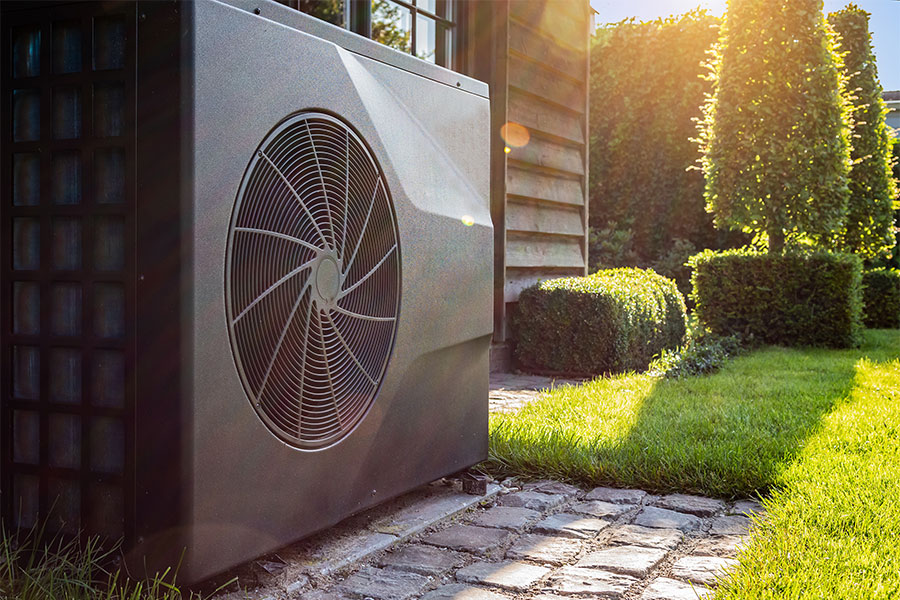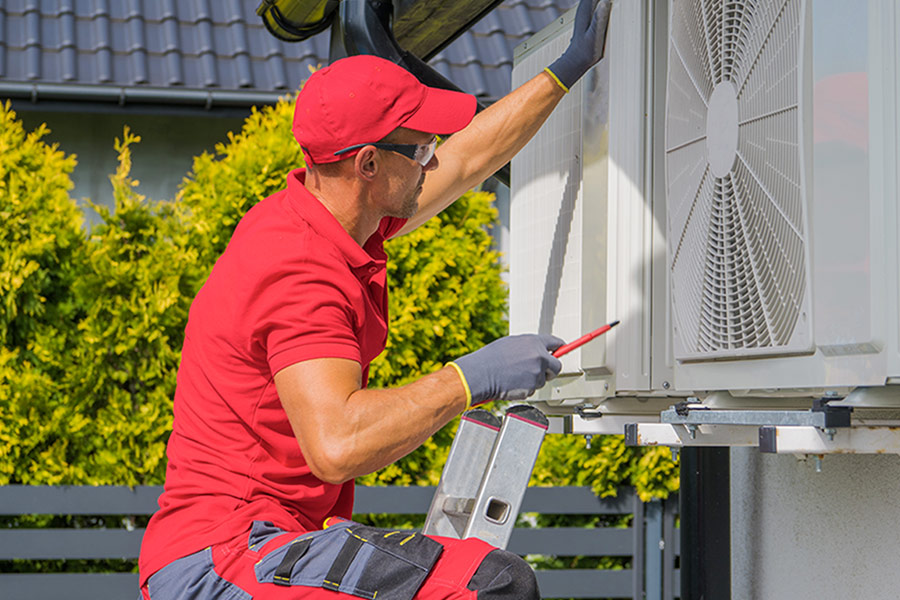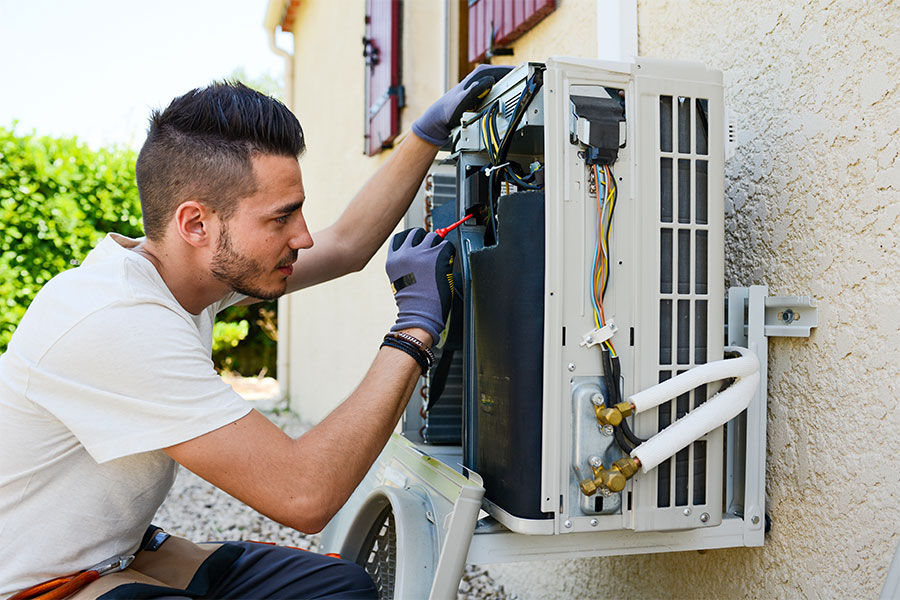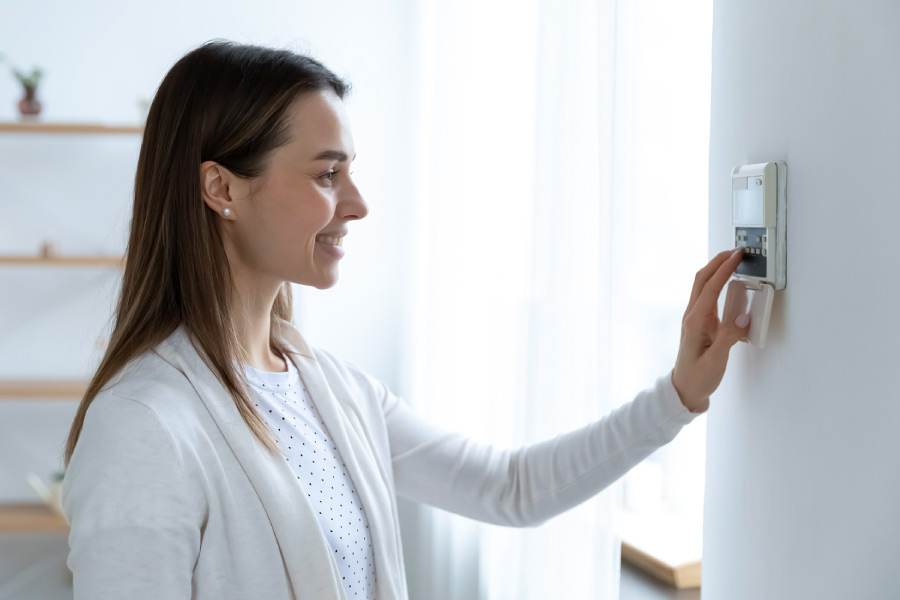
Heating and Cooling Solutions
There’s a saying in Montana: “If you don’t like the weather, just give it a moment. It will change!” The weather in Bozeman may be inclement one moment and then scorching the next, but it doesn’t matter when your home has a ductless heat pump.
Ductless heat pumps are famous for keeping homes at a comfortable temperature all year long. We’ve found that they not only optimize your home’s entire heating and cooling system, but they can even add value to your property. One of the most significant advantages of installing a ductless heat pump system is its ability to be customized for your comfort. For example, with a multiple-zone system, you can choose the temperature of each room within your home. Plus, because of the Inflation Reduction Act, homeowners can receive a 30% tax credit good towards the total cost of what you pay for a heat pump, up to $2,000. And, in addition to the tax credits, homeowners may be eligible for heat pump rebates good for up to $1,750 for a heat pump water heater and $8,000 for heat pumps for space heating and cooling.
If you’re investigating HVAC options for your household, it’s worth checking out the benefits of a ductless heat pump. Keep reading to explore what a ductless heat pump is, its advantages, and how installing a heat pump can pay for itself in energy savings.
Ductless Heat Pumps: Maximizing Your Home’s Comfort & Efficiency
What is a Ductless Heat Pump?
A ductless heat pump is an energy-efficient heating and cooling system that redistributes warm air from the outside of a home and brings it inside. It does this by pulling heat from the ground and then transferring it through the ductless heat pump system into your home. It can also do this in reverse. It can remove the warm air from inside your home and then distribute it back outside through a valve that directs the flow of refrigerant in the unit.
Ductless heat pumps contain two components that are shaped like compact rectangular boxes. One component is placed outside of the home, while an inside component is connected to pipes or ducts. The number of units inside a home can vary depending on how many rooms a homeowner wants them installed in.
These systems can also be known as “mini-split heat pumps” because they can be split into single or multiple zones. Single-zone split heat pumps cover a single-zone area within your home, while a multiple-zone split heat pump can cover multiple areas. Whether they are single-zone or multiple-zone split heat pumps, all units are connected to a thermostat.
Homeowners can’t always choose the heating and cooling systems that come with their homes. However, as a homeowner, you don’t have to live with the consequences of a heating and cooling system that is not meeting your needs, using too much energy, and failing to maximize your home’s value. Ductless heat pumps have many advantages, such as they are highly energy efficient, ideal if you only need to heat or cool a particular area of your home, and they can save on energy costs, bringing added value to your home.
What are the Advantages of a Ductless Heat Pump?
Bozeman ductless heat pump installations have risen in popularity in the Gallatin Valley in recent years. And for good reason. Homeowners appreciate having the customization of single-zone and multiple-zone areas they can personalize to the unique needs of their home. They also welcome that if their home doesn’t have ductwork installed, ductless heat pumps can be an excellent solution for heating and cooling. These and other advantages make ductless heat pumps an attractive option for homeowners deciding on whether to install one in their home.
- It can be used Year Round
- The most obvious advantage of having a ductless heat pump is that it can “reverse cycle.” This means that it can extract heat from inside your home and transfer it outside. A ductless heat pump can then bring energy from outside of your house inside, thereby cooling and heating your home as needed.
- Control the Zones in Your Home
- Ductless heat pumps allow you to control temperatures independently in different zones with multiple-zone units. This allows for personalized comfort throughout your home. It is particularly ideal if you have rooms that seem too warm or too cool. It is a good option if you have many people living in your home whose comfort levels vary.
- Highly Energy Efficient
- Ductless heat pumps are one of the most cost-effective forms of heating and cooling available, which is why they are so popular. According to Mitsubishi, one of the ductless heat pump brands we take pride in offering, “ductless heating systems can save 30-40% of the energy costs of a forced air system.
- Convenient and Safe
- With ductless heat pumps, rooms can be cooled or heated within a matter of minutes. You can switch from heating to cooling with a touch of a button. And there are no flames or hot surfaces like those with gas heating or wood stoves. So, there is no need to worry about pets, people, or furniture getting harmfully burned.
- Add Value to Your Home
- Because ductless heat pumps save an average of 30% to 70% on energy costs, they are adding value to homeowner’s homes. They are 2-3x more efficient than gas furnaces, and the savings adds up over the years.
How are Ductless Heat Pumps Installed?
Installing ductless heat pumps is relatively simple, but a licensed HVAC technician should do it because refrigerant lines will need to be installed, connected and charged. Fortunately, because these types of heat pumps are ductless, there is no need to install extensive ductwork within a home. The duration of the installation depends on how many components will need to be installed in the home. After installation is complete, homeowners can begin using their ductless systems immediately.
At Mountain Heating and Cooling, when we install a ductless heat pump, we prefer to use the best heating and cooling systems available. We prefer using Trane and Mitsubishi ductless heating pumps because they are famous for their quality, durability, and reliability. However, should you ever need Bozeman ductless heat repair, we are committed to fixing your ductless heat pump quickly, making your home comfortable again as soon as possible.
Upgrade Your Home’s Comfort & Efficiency: Call Our Team of Ductless Heat Pump Experts
If the Montana summers are feeling a little hotter and its winters a little colder, it could be time to upgrade your home’s heating and cooling systems. Ductless heat pumps are an excellent solution to making your home more energy-efficient and comfortable all year round. At Mountain Heating and Cooling, we pride ourselves on being ductless heat pump experts. Each of our HVAC technicians has received extensive, ongoing training and certification so your installation goes smoothly. We will make sure that your ductless heat pump installation exceeds your expectations. Reach out to us at Mountain Heating and Cooling.

Heating and Cooling Solutions
Many Bozeman homeowners don’t realize that their summer air conditioning habits are running their air conditioning units ragged. As the summer heat rolls in, air conditioning becomes a lifeline for many Gallatin Valley households. In contrast to Montana’s long, cold winters, summer temperatures in Big Sky Country frequently climb to the 80s and 90s, sometimes even triple digits. Air conditioning can offer wonderful relief from the heat of summer; however, you may need to change up how you run your a/c unit in the summer vs how you would run it during other months of the year.
In the summer, many homeowners make key mistakes that can weaken the efficiency of their HVAC system, making it work harder than necessary. Often, these mistakes can increase your home’s energy consumption and increase the likelihood of your air conditioning unit needing repairs.
Want to make sure your HVAC unit keeps your home cool all summer long? We’ve outlined the most common summer air conditioning mistakes to avoid along with simple solutions to help you solve them.
5 Summer Air Conditioning Mistakes to Avoid
Mistake #1: Choosing the Wrong A/C Unit Size
One of the biggest mistakes homeowners make when it comes to summer air conditioning is installing an HVAC system that is either too small or too large for their space. An undersized unit will struggle to cool your home efficiently, leading to increased energy usage and premature wear and tear. On the other hand, an oversized unit that cools the house too rapidly will cycle on and off more frequently than it should. This rapid “on-and-off” cycling wastes energy and can cause the unit to wear out before it should.
Solution: Have a Professional Measure Your Home for the Right A/C Unit Size
When choosing an HVAC unit, it’s wise to consult a professional who can accurately assess your home’s cooling needs and recommend the appropriate a/c unit size. During a load calculation test, an HVAC technician will consider your home’s duct conditions, room size, insulation, shade and sun angles, and seasonal weather conditions. Based on these considerations, they will recommend an A/C unit that matches your home’s cooling needs and does not expend excess energy.
At Mountain Heating & Cooling, we specialize in Bozeman air conditioning installation with expertise in the unique demands of mountain living conditions. Schedule an appointment with our team today to have an HVAC professional assess your home for the right A/C unit size.
Mistake #2: Opening Doors and Windows During the Day
During the hot summer days, opening doors and windows lets hot air from outside flow into your home, causing your A/C system to work harder to maintain the desired temperature.
Solution: Keep Doors and Windows Closed When Your Air Conditioner is Running
To maintain a comfortable indoor environment, keep your doors and windows closed during peak heat hours. If you want to let fresh air in, do so during the cooler hours of the early morning or late evening.
Mistake #3: Inconsistent A/C Usage
Some people make the mistake of turning off their air conditioner completely when they leave the house, assuming that they can return and quickly cool the space down to their desired temperature. However, this puts unnecessary strain on the system and can result in increased energy consumption.
Solution: Set Your Thermostat To a Slightly Higher Temperature When You’re Away to Maintain a Stable Indoor Environment
Setting your thermostat to a slightly higher temperature when you’re away allows the A/C unit to maintain a more stable indoor environment. A Trane air conditioner, for example, has a maximum temperature setback (aka “setback” or “setback programming”) of 4 degrees Fahrenheit while you’re out of the house or during certain periods of the day. So if you want your home to be at 72 degrees by 6 PM, set the daytime maximum temperature at 76 degrees when you’re away. The purpose of an A/C unit setback is to save energy and reduce cooling costs without sacrificing comfort.
Mistake #4: Setting the Temperature Too Low
Did you know setting your thermostat to an excessively low temperature doesn’t cool your home faster? In reality, it just makes your air conditioner work harder and consume more energy.
Solution: Set Your A/C Unit for a Comfortable Temperature that Allows Your A/C System to Operate without Strain
A recommended summer air conditioning temperature setting is in the 70-degree Fahrenheit range during the summer months. This temperature can help maintain a balance between comfort, unit efficiency, and energy savings. Also, consider using ceiling fans or portable fans to amplify the cooling effect.
Mistake #5: Putting Off Regular Maintenance and Repairs
Proper air conditioning system maintenance is essential to ensure its longevity and efficiency. Neglecting routine maintenance—such as filter cleaning or replacement—can lead to reduced airflow and decreased cooling performance. In some cases, putting off maintenance can actually lead to you needing to replace the entire unit and have a new air conditioner installed. Wondering if your air conditioner is on its last legs? Check out our post on the signs it’s time to repair or replace your air conditioner.
Solution: Schedule Regular Maintenance
Plan for regular or seasonal maintenance with trusted HVAC professionals to inspect and tune up your system. At Mountain Heating & Cooling, we can identify and address any issues promptly, helping prevent breakdowns and avoid expensive repairs.
Wondering if you might need Bozeman air conditioning repair services? If your unit isn’t running well, contact us to assess your system and provide recommendations for a new, energy-efficient unit that suits your needs. We can also help you upgrade to a new Trane air conditioning system for enhanced energy efficiency and long-lasting reliability in your home.
Avoid Common A/C Mistakes and Stay Cool and Comfortable All Summer Long
Whether your A/C unit is new or old, it’s important to be mindful of the common summer air conditioning mistakes that can compromise your home’s comfort levels. From choosing the right unit to scheduling regular maintenance, simple actions can help avoid surprises down the road. As your trusted Bozeman A/C repair and installation experts, the Mountain Heating & Cooling team is here to help ensure your HVAC system keeps running smoothly and efficiently, all season long. Reach out to us today for a consultation.

Heating and Cooling Solutions
They happen to everyone—air conditioner repairs. They creep up when you least expect it but more frequently as you head into the spring and summer. As you start using your air conditioner more in the warmer months, sometimes your air conditioner shows warning signs of needing a repair, especially if it’s older or hasn’t been properly maintained in a while.
In the end, even the best air conditioners need to be repaired at some point, but staying on top of any repairs can save you a lot of time and money in the long run. So you don’t end up in the thick of summer without a well-functioning air conditioner, we’ve pulled together a list of air conditioner repairs to keep an eye out for. If you notice any of these problems or have any concerns about your air conditioner’s performance, contact our team of Bozeman air conditioning repair professionals for help.
9 Common Air Conditioner Repairs
1. Faulty Thermostat
A malfunctioning thermostat can cause your air conditioner to run too frequently, not enough, or not at all. Without proper repairs, an improperly functioning thermostat can cause your energy bills to skyrocket, lead to uneven cooling of your home, or result in your home not being cooled at all when you need it most. A few causes for a malfunctioning thermostat include wiring issues, incorrect thermostat placement, a broken thermostat sensor, and power problems.
2. Drainage Issues
Your air conditioner’s drain line—responsible for carrying away condensation on the evaporator coil—can often be the culprit for needing a repair. Drain lines can become clogged or obstructed over time, which can lead to water backing up into the HVAC system and causing damage.
3. Electrical Problems
Electrical issues can cause a wide range of problems that could lead to you needing air conditioner repair services. From faulty wiring and loose connections to a tripped circuit breaker and corrosion, electrical problems can cause your air conditioner to wear out too quickly and need repairs.
4. Faulty Capacitors
Capacitors are essential to air conditioning units. Without them, the motors that power the fans and compressor won’t function properly. If you have a faulty, old, or dirty capacitor, it can cause your air conditioner to fail and need repairs.
5. Low Refrigerant or Leaks
Refrigerant is the substance that circles through your air conditioning system and is responsible for cooling the air that is blown into your home. If you have low refrigerant levels, your air conditioner will blow warm air or not cool the air at all. Sometimes, a leak in the evaporator coil, condenser coil, or connecting lines can cause your refrigerant levels to get low and cause damage to your HVAC system. Regular air conditioner maintenance can help you avoid low refrigerant levels and leaks, extending the lifespan of your air conditioner unit.
6. Dirty Air Filters
One of the main culprits for why your air conditioner isn’t working properly is your air filter. Dirty or clogged air filters reduce airflow through your air conditioner and, in severe cases, can cause your unit to freeze. Regular maintenance and changing of your air filter can help keep your air conditioner in tip-top shape and avoid the need for intensive repairs.
7. Dirty Air Conditioner Coils
Your air conditioner has two coils: the condenser coil (located outdoors) and the evaporator coil (located indoors). Both of these coils have refrigerant running through them and help regulate the cooling functionality of your air conditioner unit. However, when these coils become dirty, the coils are unable to properly cool your home, resulting in your unit running longer than it should and pushing hot air into your home. An experienced HVAC technician can clean your air conditioner’s coils and return them to an optimal state.
8. Failing Blower Motor
The blower motor is essential to your air conditioner, as it’s responsible for circulating cool air throughout your home. When the blower motor fails, you experience reduced airflow and poor cooling performance throughout your home. Sometimes, you can even hear that your blower motor is failing, as your air conditioner may produce a humming, grinding, or rattling noise. If you suspect your blower motor may be failing, reach out to an air conditioning repair technician immediately to assess and remedy the issue. Delaying repairs can lead to further system damage and costly repairs.
9. Bad Compressor
The compressor is one of the most expensive components of your air conditioning system. The heart of the air conditioning unit, the compressor circulates refrigerant throughout your air conditioning unit. They can typically last between 10 and 15 years with proper maintenance, but lack of proper care can lead to harsh wear and tear on your compressor. Debris, dust particles, and refrigerant leaks can lead to the breakdown of your compressor, so having your compressor regularly maintained can save you expensive repairs in the long run.
Should I Repair My Air Conditioner Unit or Replace it?
If your air conditioner starts having problems, sometimes repairing your air conditioner unit is the best option. If its age and warranty are still good and the repairs are manageable, you likely do not need to replace your entire air conditioning unit at this time. However, there are cases when it is better to buy a new air conditioner rather than invest money in upkeeping your current unit. Here are a few signs it’s time to replace your air conditioner:
- Odd noises are coming from your unit
- The air smells strange
- Your energy bills are higher
- Your home’s air quality is poor
- Your airflow is weak
- The AC unit needs frequent or expensive repairs
- Your AC unit is over 10 years old
- Your air conditioner uses R-22 refrigerant
If you need advice selecting a new air conditioner for your home, check out our resource on how to choose the right air conditioner type for your home and our recommendations for the best air conditioner brands. If you have any questions, don’t hesitate to give our Bozeman HVAC team a call or shoot us a message—we can help you pick the best air conditioner for your needs!
Bozeman Air Conditioning Installation & Repair Services
Are you in the market for a new air conditioner or need your system repaired before the warm weather hits? We’ve got you covered! At Mountain Heating and Cooling, our team of NATE-certified technicians is here to diagnose and solve every air conditioning problem you may encounter. Whether you need your Trane air conditioner serviced before the long summer months, an air filter replacement, or a full air conditioner installation appointment, you can depend on our team to make sure your home stays comfy and cool. Schedule an appointment today!

Heating and Cooling Solutions
The days are getting longer, the grass is greening up, and you can comfortably venture outside with fewer layers: it must be springtime in Montana! As you’re enjoying the warmer weather and planning for the summer, take time to prepare your home’s air conditioner for prime cooling performance. Spring is the perfect time to schedule any air conditioner repair service so your A/C unit is summer-ready and you don’t have to face longer wait times for an HVAC repair technician in June, July, and August.
The quick transition from heating in the winter to cooling in the summer can, sometimes, shock your HVAC unit and reveal any lingering issues in your air conditioning system. Often, these issues can cause your air conditioner to break down. By scheduling any necessary air conditioner maintenance or repair services early in the spring season, you can be confident that your system will be ready to keep your home cool and comfortable all summer.
In fact, getting your home’s HVAC unit professionally maintained twice a year, at the beginning and end of each summer season, may increase the lifespan of your unit by five years. A maintenance appointment includes a professional walkthrough and cleaning by one of our highly trained technicians. We will proactively diagnose and address any needed repairs quickly and cost-effectively, ensuring that your HVAC unit runs smoothly when things heat up.
Are you wondering if you need air conditioner repair services or seasonal air conditioner maintenance? We recommend turning the unit on for a short run during one of the first warm spring days of spring and watching for any of the warning signs indicated in the below checklist. If you notice something amiss, call Mountain Heating and Cooling at (406) 586-4007 or schedule an appointment online—our Bozeman air conditioner repair experts are here to help!
Checklist: 6 Signs You Need Air Conditioner Repair Services
1. The A/C system is blowing warm air
If you’re running your air conditioner and there’s warm air coming out of your vents, start by checking the thermostat to make sure it’s set to cooling mode. Then set the temperature so it is lower than the ambient temperature of your home. If the air conditioner is still blowing warm air, it could point to a compressor issue or restricted airflow somewhere in the unit or vents.
2. The airflow is weak
If your vents are barely pushing air, it might mean your air conditioner’s air filter is clogged or the motor is broken. Insufficient airflow can come from several other issues too, so contacting a professional HVAC contractor right away is key to addressing and resolving any problems.
3. The A/C unit is making noises
Most units make a little more noise as they cycle on or off than they do when they are in their cooling cycle. But if you hear grinding, squealing, rattling, or scraping sounds, it might mean a loose part or another issue. The complex nature of these units means that one broken part has the potential to cause damage elsewhere, so “listen” to this sign that it’s time to schedule air conditioner repair services.
4. There is a strange smell coming from the vents
If the air coming from the vents in your home has a burning or musty smell, it might mean your air conditioner needs some fine-tuning or the unit and vents need a thorough cleaning. Proper air conditioner functioning is essential for the health of your unit, and clean air is vital for your and your family’s health.
5. Puddling or humidity
An A/C unit should actually de-humidify your home, and the condensation has to be removed from your home through pipes or tubes. Over time the condensation removal route can become blocked or kinked. Watch for moisture either near the indoor furnace or air handler. Pooling of condensation around the indoor unit may indicate a blocked tube or leaking condensation from the coil. In this case, you’ll want to contact a professional immediately and turn off the unit because as long as you’re cooling you will create more condensate and have the risk of creating water damage.
6. The thermostat isn’t working
Sometimes, the problem isn’t the A/C unit—it’s the thermostat. A broken or malfunctioning thermostat might cause obvious issues, like air temperature that’s way off from the thermostat setting, or it could be more subtle, like an HVAC zoning system that isn’t accurately controlling different rooms or areas as expected. Whatever the problem may be, our technicians can quickly diagnose, recalibrate, or repair your thermostat.
Your Trusted Team for Bozeman Air Conditioner Repair Services
If you noticed any of the previously mentioned warning signs, it’s time to schedule a repair. We recommend scheduling air conditioner repair services or seasonal maintenance early to make sure everything is running well when it matters most. Should any issues arise, we are here to help address any emergency repairs.
If your air conditioner is beyond the point of repair and you are considering upgrading your unit, our Bozeman air conditioner installation team can walk you through the process of selecting the best HVAC system for your home, budget, and lifestyle. Our highly trained technicians will travel to your home in the Gallatin Valley, Belgrade, Park County, and beyond.
Let us help you get ahead of the summer heat. Reach out today to schedule your seasonal A/C appointment with Mountain Heating & Cooling.

Heating and Cooling Solutions
We rely on our furnaces to keep us safe and warm throughout the long winter months, but emergency furnace repair services can pop up from time to time. When temperatures drop below zero and snow drifts start to pile up, a functional, dependable furnace is a lifesaver. But a malfunctioning furnace or HVAC can put us (and our families) in potentially life-threatening situations—from house fires to carbon monoxide poisoning.
In general, furnaces are totally safe, and safety issues are rare. However, occasionally, a furnace problem can arise and lead to more serious emergencies that can cause some damage to your wallet, health, and home. Fortunately, there are “symptoms” to watch out for. We created a list of five warning signs that you may need emergency repair services. If you notice any of these issues, call our team for an emergency furnace repair to keep your home safe and toasty warm. Our team specializes in Bozeman HVAC repair services, and we can help quickly diagnose and resolve furnace emergencies. In case of an emergency, contact us here or call our Mountain Heating & Cooling team at (406) 586-4007.
5 Signs You Need an Emergency Furnace Repair
Sign #1 — Your furnace is running improperly
Is your furnace cycling too quickly, turning on and off when it should run more continuously, or not shutting off the fan? Maybe your furnace is only blowing cold air or won’t turn on at all. If these problems are not being caused by a thermostat setting issue (like the fan being set to “on” rather than “auto”), it’s time to call an HVAC repairman. A professional can quickly diagnose and fix the issue, whether it’s a mechanical problem, an electrical failure, a thermostat issue, or something with the furnace itself.
Sign #2 — There’s a strange or unpleasant smell coming from the furnace or vents
A musty or “off” odor could be caused by a simple issue with an easy fix, such as replacing the air filter or getting the ducts cleaned. But smells like smoke, rotten eggs, burning plastic, metal, or chemicals are often signs that it’s time to reach out to an emergency furnace repair professional.
A Rotten egg or a sulfur-like smell is a major indicator of furnace issues since this smell often indicates a natural gas leak. Because natural gas is odorless, gas companies add a harmless chemical called mercaptan to ensure leaks are easy to detect. Natural gas leaks can cause fires or explosions with little warning. So if you smell this odor, leave the house with your family and pets right away, and don’t turn lights on and off or plug things in (sparks can be dangerous with this combustible gas). Once you’re safely away from the house, call your utility company and the fire department, and they will tell you what to do next.
Other smells may indicate major furnace issues but don’t carry as much immediate danger. For example, a metallic smell might mean your furnace is overheating. If you smell a burning metallic odor from your furnace, turn it off and call an HVAC repair technician. A chemical or formaldehyde-like smell could be a sign of cracks in the furnace’s heat exchanger. Contact a professional HVAC repairman immediately to ensure there’s no risk of carbon monoxide poisoning or other issues.
Sign #3 — The furnace has a yellow or orange flame instead of blue.
When a natural gas furnace is functioning correctly, the pilot light will appear blue. Efficient combustion creates a hot, blue flame, often with a light blue triangle at its center. This indicates that a furnace is in good working order with complete gas combustion.
If a pilot flame is yellow or orange, that can indicate incomplete or ineffective combustion. This might happen with an older furnace nearing the end of its lifespan, or it might just mean a furnace is due for a cleaning, part replacement, or repair. Sustained yellow or orange flames can indicate the possibility of a carbon monoxide leak. In these cases, it’s best to turn off your HVAC system and contact a Bozeman HVAC repairman.
Sign #4 — You notice puddles, steam, or condensation around the furnace
Is your furnace creating steam, condensation, or pooling water? Any of these symptoms mean that the furnace or boiler has sprung a leak or has a valve issue. A properly functioning furnace will not create condensation—modern furnaces use cooling exhaust to increase their energy efficiency, and the moisture gets vented away before it has a chance to condense and pool up. But a puddle means it’s time for furnace repair. Typically, this type of issue can be easily resolved, but if it traces back to the heat exchanger, it can be a more serious problem.
Sign #5 — A carbon monoxide detector is going off
Any time a carbon monoxide detector goes off, it’s vital to pay attention, take it seriously, and take safe action. If ignored or unnoticed, carbon monoxide can cause sickness and even death. Every year, it kills hundreds of people and makes thousands of others ill. If your detector has been triggered, it may be due to any number of issues—whatever the cause, it’s critical to get the problem addressed immediately and schedule an emergency furnace repair.
Your Trusted Bozeman Heating and Cooling Specialists for Emergency Furnace Repair
When your furnace is malfunctioning or you notice any of these warning signs, we recommend reaching out to the professionals immediately. Scheduling emergency heating repairs is more than a matter of comfort and convenience; it’s key to keeping you, your family, and your house safe.
We recommend seasonal HVAC checkups and routine cleanings to help prevent furnace emergencies before they happen. With all home systems, it’s normal for equipment and components to deteriorate over the years, but proactive maintenance can help prevent avoidable failures. If you are wondering if your furnace is due for a checkup, reach out to get scheduled with a pro from Mountain Heating & Cooling.
Our experienced Bozeman HVAC repair technicians specialize in accurately diagnosing and repairing all types of furnace issues. Mountain Heating & Cooling works hard to provide prompt and professional service — because should an emergency arise, you deserve the peace of mind that you’re well taken care of. We are always here to help with any issue, large or small.

Heating and Cooling Solutions
Whether you’re shopping for a furnace for the first time, looking for an upgrade, or just exploring your options, it can feel overwhelming to know where to start. We’re breaking down the differences between single stage vs two stage vs variable speed furnaces to help you decide which is best for your home.
Topics
Single Stage vs Two Stage vs Variable Speed Furnace — How Do They Work?
To understand the difference between your single stage vs two stage vs variable speed furnace options, it’s helpful to know the basics about how a furnace regulates temperature in a home.
A furnace’s capacity is measured in BTU output, otherwise known as heat output. Your furnace’s capacity is based on the coldest days in your region. If you live in a cold area, as we do here in Montana, your home will (or need) a furnace with a higher capacity. Some furnaces run only at 100% capacity—they operate at full capacity for a few minutes, then cycle off, then cycle back on again. Other furnaces can operate at different capacities, allowing them to blow air that’s “hotter” rather than “hottest.” A furnace is classified as single stage, two stage, or variable speed based on how many power levels it can run.
Pros and Cons
Single Stage Furnace
A single stage furnace is the simplest type of furnace with just two settings: on or off. That means it runs at full capacity or not at all.
Pros
A primary advantage of a single stage furnace is the lower price point. Single stage furnaces have simpler communication needs, so the cost for smart thermostats can be less.
Cons
One of the drawbacks of single stage furnaces is that when they are used to heat a large or multistory home the ambient air temperature can vary widely by floor. Because the furnace operates at full capacity for every cycle, the air temperature nearest vents warms up faster than areas further away. The challenge is the location of the thermostat in relation to the varying temperatures of the rooms throughout the house. The thermostat might “think” the entire house is at the temperature you’ve selected on your thermostat and shut down the furnace cycle too soon, leaving cold spots and even cold rooms further away from the vents.
In addition, a single stage furnace starts blowing at full blast as soon as it turns on. While it heats areas quickly overall, some air that’s not fully warmed is blown into your living spaces at the start of each heating cycle. The noise of this fan speed, particularly in a poorly-designed duct system, often can cause a need for higher TV volumes or dinner conversations. Since they only operate at one level, single stage furnaces tend to use power less efficiently—the same as if you were to only drive your car at 100mph versus cruising the highway at a gas-friendly 75mph. The START/STOP of the fan is particularly efficient.
Two Stage Furnace
Two stage furnaces, also called dual stage furnaces, have three settings: low mode, high mode, and off. Two stage furnaces typically run on low mode and kick into gear only when the weather is cold enough or it needs to create more heat to accomplish a large gap from the current temperature to the requested thermostat set point. On milder days, two stage furnaces decrease their output from 100% BTUs to a lower setting, adjusting both the amount of energy being used and the blower fan intensity. The result is that they can run longer and maintain a thermostat setting with more accuracy. They also boast improved efficiency and quieter fan heat and cool cycles.
Pros
Along with efficiency, accuracy, and quieter cycles, an added benefit of two stage furnace systems comes from the longer runtime. The longer runtime moves more air through the filter throughout the day, cleaning out allergens, dust, and other debris. What this means is that it creates more comfort in a wider range of rooms in your home.
Two stage furnaces typically cost more than single stage, but for a good reason. They can warm a larger or multistory home much more evenly, consistently, and with better cost-efficiency. A more significant investment here can significantly lower your heating bill in the long run.
Cons
Two stage furnaces are generally a solid choice for most homeowners, but they cost more than single stage. They also will require a new thermostat if you are transitioning from a single stage furnace in order to control the additional low-to-high fan options being added to your home.
Variable Speed Furnace
This is the most comfortable and efficient of the three furnace styles. Similar to two stage furnaces, variable furnaces can cycle at different capacities for the highest possible comfort level in your home.
Pros
If one stage makes a home comfortable, and two stages make it even better, multiple stages can create true luxury, with steady temperature and even heat—no cold or hot spots throughout the home, and no spikes in temperature throughout the day. Depending on the model, variable furnaces can produce heat at anywhere from 100% capacity to as low as 40%.
With a variable speed furnace, you will never be limited in your future choices for air conditioning, zoning, or air filtration. A variable speed furnace can work with a single speed air conditioner, provide year-round comfort for your home, allows for more consistent air flow throughout the home, and provides better air filtration.
Cons
The drawbacks of variable furnaces are primarily in their price point. You’ll want to make sure you choose a reputable contractor who’s able to set up the furnace controls so you reap the benefits of the furnace. We’ve often gone into homes where customers have a top-of-the-line furnace with a thermostat that was miswired or not programmed to match their variable speed furnace.
How to Choose Which is Best for You
Single stage furnaces are a good choice for budget-conscious buyers heating a small to medium-sized, single-story home. These furnaces are simple and highly reliable, heating your space with less of an upfront investment on equipment.
Two stage furnaces increase the comfort and efficiency factors, making them an excellent midrange option for larger or multistory homes. These furnaces can help decrease heating bills with more consistent ambient temperature from steady, warm airflow.
Variable speed furnaces are the highest efficiency models, heating a household with fine-tuned capabilities. These are investment pieces that deliver predictable returns when it comes to maximizing comfort and are less of an investment in the monthly costs of heating and cooling your home.
Choosing between a single stage vs two stage vs variable speed furnace will depend on your budget, the size of your home, and your desired comfort level.
If you’re still considering your best option for Bozeman furnace installation, Mountain Heating & Cooling can help. As your local HVAC experts, we understand the heating needs of homeowners in the Gallatin Valley and beyond. We specialize in Trane furnace installation and servicing, helping you take advantage of the most reliable, high-quality HVAC systems on the market. Whether you’re looking for a Trane single stage furnace, a two stage model, or a variable speed system to heat your home, we’re here to help you navigate the decision with confidence. You can depend on our friendly, respectful team with extensive HVAC training to deliver the quality service you and your family deserve.
Reach out to our team today with questions about choosing a furnace for your home, or schedule an appointment with our team. We’re here to make your home safe and comfortable year-round.






